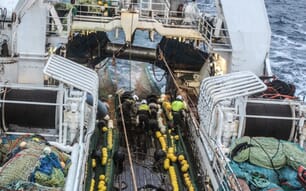A large portion of the poisonous chemicals used in the Second World War were disposed of at sea. After the war, they were thrown overboard at designated sites, mainly in the Bornholm and Gotland basins of the Baltic Sea. These substances included sulphur mustard (blister gas); Clark and other types of arsines (e.g. Clark 1, or diphenyl arsine, is a gas which causes vomiting); arsenic-containing Adamsite (also a nose and throat irritant); and α-chloroacetophenone (tear gas). Arsenic and mustard warfare agents have been found in sediments at dumping sites, evidence that the chemicals can leak from damaged or corroded casings and contaminate the surrounding area.
This study, partly funded by the EU through the CHEMSEA project, investigated cell and genetic damage of fish living in the dumping zones in the Bornholm Basin of the Baltic Sea. The area is important as a spawning ground for commercially valuable fish species.
The researchers collected samples of flounder (Platichthys flesus), herring (Clupea harengus) and cod (Gadus morhua), caught with standard bottom trawls at 42 study stations in the Bornholm Basin from November 2010 to February 2012. Flounder, herring and cod samples had previously been taken from four other sites in the same area in 2003, 2004 and 2009 and these were used for comparison with the 2010-2012 samples. The 2010-2012 sampling campaign included 188 flounder from 23 stations, 307 herring from 31 stations and 127 cod from 10 stations. They then examined blood samples taken from the fish for evidence of damage to red blood cells. Abnormalities in cellular structures, such as changes in the nucleus, are indicative markers of genotoxicity and cytotoxicity – damage to cells and genetic material – caused by toxic chemicals.
Extremely high genotoxicity risk levels for flounder were found at 21 of the 23 stations, compared to reference levels taken from fish in uncontaminated areas, for herring at 29 of the 31 stations and for cod at 5 of the 10 examined stations.
The researchers also found that fish from the 42 stations in 2010-2012 had substantially higher levels of genetic damage compared to samples taken between 2003-2009. The study’s authors suggest that recent undersea construction projects, for instance, the laying of gas pipelines and cables and mine clearance between 2008 and 2011, may have disturbed the dumped munitions. This suggests that the effects of such activities on marine life in the area should be closely monitored.
Although the Baltic Sea is highly contaminated with other pollutants originating from human activities, the highest genotoxicity risk areas were found in or close to known warfare dumping zones, suggesting that chemical warfare agents were the most likely cause of the cellular damage seen in the fish.
Overall, the study highlights the value of using fish as indicators of the pollution caused by chemical warfare agents dumped in the Baltic Sea, the researchers conclude.




